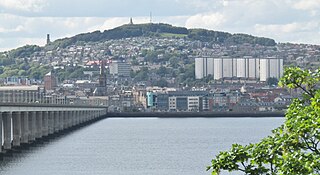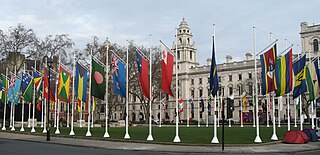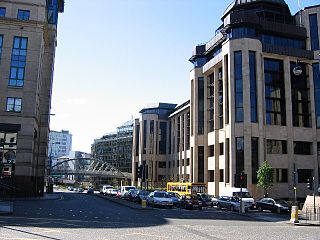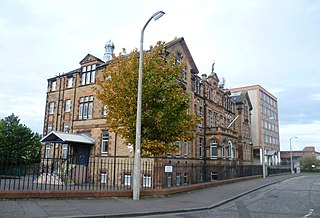Related Research Articles

Boxing Day is a holiday celebrated after Christmas Day, occurring on the second day of Christmastide. Boxing Day was once a day to donate gifts to those in need, but it has evolved to become a part of Christmas festivities, with many people choosing to shop for deals on Boxing Day. It originated in the United Kingdom and is celebrated in several Commonwealth nations. The attached bank holiday or public holiday may take place on 28 December if necessary to ensure it falls on a weekday. Boxing Day is also concurrent with the Christian festival Saint Stephen's Day.

Dundee is the fourth-largest city in Scotland. The mid-year population estimate for 2016 was 148,210, giving Dundee a population density of 2,478/km2 or 6,420/sq mi, the second-highest in Scotland. It lies within the eastern central Lowlands on the north bank of the Firth of Tay, which feeds into the North Sea. Under the name of Dundee City, it forms one of the 32 council areas used for local government in Scotland. Within the boundaries of the historic county of Angus, the city developed into a burgh in the late 12th century and established itself as an important east coast trading port. Rapid expansion was brought on by the Industrial Revolution, particularly in the 19th century when Dundee was the centre of the global jute industry. This, along with its other major industries, gave Dundee its epithet as the city of "jute, jam and journalism".

The Royal Mile is a succession of streets forming the main thoroughfare of the Old Town of the city of Edinburgh in Scotland. The term was first used descriptively in W. M. Gilbert's Edinburgh in the Nineteenth Century (1901), describing the city "with its Castle and Palace and the royal mile between", and was further popularised as the title of a guidebook by R. T. Skinner published in 1920, "The Royal Mile (Edinburgh) Castle to Holyrood(house)".
Public holidays in Australia refer to the holidays recognised in law in Australia. Although they are declared on a state and territory basis, they comprise a mixture of nationally celebrated days and holidays exclusive to the individual jurisdictions.

Victoria Day is a federal Canadian public holiday observed on the last Monday preceding May 25 to honour Queen Victoria, who is known as the "Mother of Confederation". The holiday has existed in Canada since at least 1845, originally on Victoria's natural birthday, May 24. It falls on the Monday between the 18th and the 24th (inclusive) and, so, is always the penultimate Monday of May. Victoria Day is a federal statutory holiday, as well as a holiday in six of Canada's ten provinces and all three of its territories. The holiday has always been a distinctly Canadian observance and continues to be celebrated across the country. It is informally considered the start of the summer season in Canada.

In the United States, public holidays are set by federal, state, and local governments and are often observed by closing government offices or giving government employees paid time off. The federal government does not require any private business to close or offer paid time off, as is the case for most state local governments, so employers determine which holidays to observe.

Commonwealth Day is the annual celebration of the Commonwealth of Nations, held on the second Monday in March. While the date holds some official status in select member states of the Commonwealth, observances of the date are not uniform across the Commonwealth, and the date is not celebrated as a public holiday in most Commonwealth countries.

Public holidays in New Zealand consist of a variety of cultural, national, and religious holidays that are legislated in New Zealand. Workers can get a maximum of 12 public holidays and a minimum of 20 annual leave days a year.

The King's Official Birthday is the selected day in most Commonwealth realms on which the birthday of the monarch is officially celebrated in those countries. It does not necessarily correspond to the date of the monarch's actual birth.
Public holidays in Canada, known as statutory holidays, stat holidays, or simply stats, consist of a variety of cultural, nationalistic, and religious holidays that are legislated in Canada at the federal or provincial and territorial levels. While many of these holidays are honoured and acknowledged nationwide, provincial and territorial legislation varies in regard to which are officially recognized.
In the United Kingdom, public holidays are days on which most businesses and non-essential services are closed. Many retail businesses do open on some of the public holidays. There are restrictions on trading on Sundays, Easter Day and Christmas Day in England and Wales and on New Year's Day and Christmas Day in Scotland. Public holidays defined by statute are called "bank holidays", but this term can also be used to include common law holidays, which are held by convention. The term "public holidays" can refer exclusively to common law holidays.

Cameron Toll is a suburb located to the south of Edinburgh, Scotland. Originally it was the site of a toll house built in the early 19th century, which was located on a stretch of road between Edinburgh and Dalkeith. Today the area is home to Cameron Toll Shopping Centre, which opened in 1984. The meaning of the name Cameron is suggested to be 'crooked hill', derived from the Scots Gaelic 'cam', crooked, and Old Irish 'brun' meaning hill, believed to refer to Arthur's Seat clearly visible nearby; the original name may have been Pictish. There are a few small housing estates to the east of the area.

Edinburgh, the capital city of Scotland, is a powerhouse of the Scottish economy, as well as the wider UK economy. Edinburgh has been consistently one of the most prosperous parts of the country and has the strongest economy of any city in the UK outside London. Financial Times FDi Magazine has named Edinburgh as the "Best Large European City of the Future" and "Best Foreign Direct Investment Strategy " for 2012/13.
Dundee is the fourth-largest city in Scotland with a population of around 150,000 people. It is situated on the north bank of the Firth of Tay on the east coast of the Central Lowlands of Scotland. The Dundee area has been settled since the Mesolithic with evidence of Pictish habitation beginning in the Iron Age. During the Medieval Era the city became a prominent trading port and was the site of many battles. Throughout the Industrial Revolution, the local jute industry caused the city to grow rapidly. In this period, Dundee also gained prominence due to its marmalade industry and its journalism, giving Dundee its epithet as the city of "jute, jam and journalism".
Until the industrial revolution, the current City Centre represented the full extent of the City of Dundee, Scotland. Now roughly encircled by the market gait dual carriageway, the city centre is now the main shopping and commercial district. Unlike the city centre of Glasgow, many of the city centre's streets are not built on a grid plan and in that way have more in common with the street plan of the Old Town of Edinburgh.

Bank holidays in Scotland are determined under the Banking and Financial Dealings Act 1971 and the St Andrew's Day Bank Holiday (Scotland) Act 2007. Unlike the rest of the United Kingdom, most bank holidays are not recognised as statutory public holidays in Scotland, as most public holidays are determined by local authorities across Scotland. Some of these may be taken in lieu of statutory holidays, while others may be additional holidays, although many companies, including the Royal Mail, do not follow all the holidays listed below; and many swap between English and local holidays. Many large shops and supermarkets continue to operate normally during public holidays, especially since there are no restrictions such as Sunday trading rules in Scotland.

The Royal Arch was a structure erected in Dundee, Scotland, between 1849 and 1853 and demolished in 1964. The monumental archway formerly stood over the access to the pier between Earl Grey Dock and King William IV Dock on the city's waterfront.

Trinity Academy is a state-run secondary school in the north of Edinburgh, Scotland. It is located on the border between Trinity and Leith, next to Victoria Park, and a short distance from the banks of the Firth of Forth at Newhaven.

George Street is the central thoroughfare of the First New Town of Edinburgh, planned in the 18th century by James Craig.
Events from the year 1966 in Scotland.
References
- ↑ "Public holiday dates in 2015". The City of Edinburgh Council. Retrieved 15 September 2015.
- 1 2 "Public Holidays in Dundee - Dundee City Council". Archived from the original on 11 April 2009.
- ↑ Goudie, Katie. "Public holidays". www.edinburgh.gov.uk.